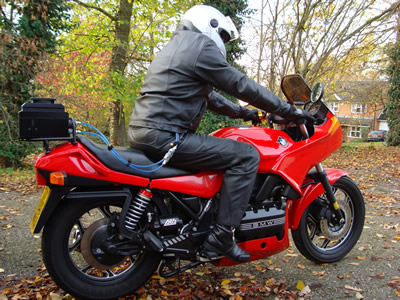
One sunny day and after putting on my leathers I was already very hot before I’d started riding. How could I stay cool?
After a bit of experimentation with air-to-air Peltier (TEC) units, I quickly realized that I’d have to pump the cold air into the jacket and somehow make sure it circulated where it was needed. The other issue was that the incoming air would require a filter; no motorcyclist wants to pump vehicle fumes and road dust into his jacket. It was also apparent that the ambient hot air would require a lot of cooling and hence power to work at all. I then thought about circulating cold water around the jacket, the more I worked on the problem the simpler this solution became. Water is a better conductor than air and the biggest bonus was that I had a closed system. All the work heating or cooling the water stays within the system unlike the pumped air method.
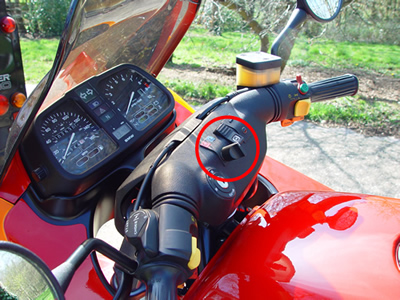
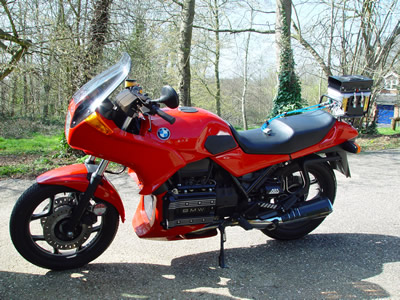
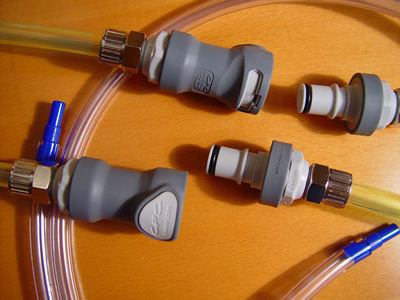

The jacket has two pairs of feed lines to balance the flow across the jacket.
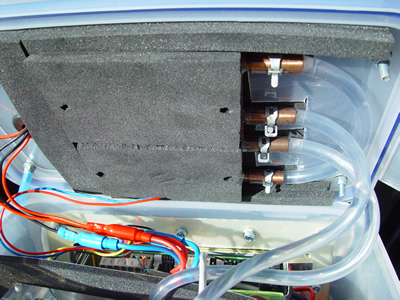
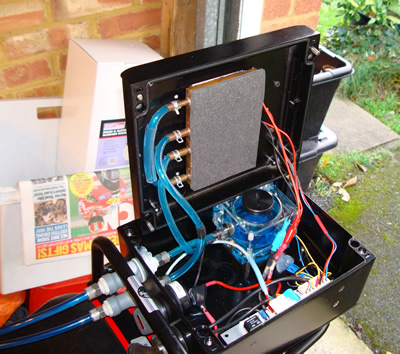
My K75S supplies about 13-13.5 volts to the battery (12/25 standard), the heat exchanger unit draws between 120-170 watts. The alternator is rated at 460 watts.
The Delta Tmax (maximum temperature difference between the hot side and the cold side) for the TEC units is 70°C (158°F).
The liquid heat exchangers cool down to about -25°C (-13°F) without water circulating – ambient temperature about 25°C (77°F).
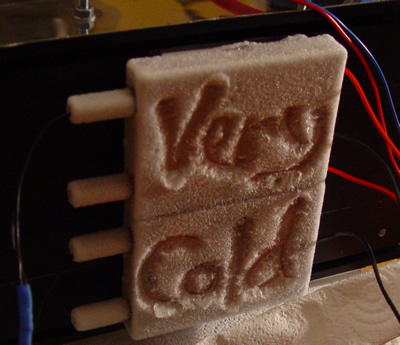
With water circulating in the jacket and the same ambient temperature (25°C, 77°F) – it cools down to 14°C (57°F).
The Peltier TEC units; controller; pump and fan draw about 120 watts in a steady state when at maximum setting.
On test, wearing leathers with a high ambient temperature of 30-32°C (86-90°F), the jacket water temperature was between 20 to 23°C (68-73°F).
The heat exchangers can reach 70°C (158°F) and rising during a heating cycle with water circulating the jacket – ambient temperature 25°C (77°F). The controller sets the maximum output water temperature to the jacket at 55°C (131°F).
On test, wearing leathers with a low ambient temperature of 2-5°C (35-41°F), the jacket water temperature was 35-40°C (95-104°F).
On test, means motorway and urban driving, with headlights on for 90 minutes.

The Competition.
There is nothing currently available that provides both heating and cooling in one package. There are plenty of heating solutions that utilise resistance wire and chemical packs. There are jackets that contain chemical packs that have been placed in a freezer and provide cooling until exhausted, these are very heavy and provide a limited duration of cooling. Some jackets may be soaked in water and provide cooling through evaporation – not very comfortable. I have seen a patent for an air based system but I doubt that it works efficiently for the reasons given above.
Critique of heating/cooling system.
The air side heat exchanger is large and will need to be reduced in size without loss of efficiency. All the prototype components used are “off the shelf” and are the best fit for the application. Research and development will yield a smaller and more efficient system utilising bespoke integrated components.
The pump/reservoir and power control unit can be placed anywhere on the vehicle but the heat exchanger requires a position on the motorcycle where there is an adequate flow of air.
The jacket connectors are easy to use and can be connected/disconnected quickly – the down side is that there are two connectors – connector manufacturers do offer single connectors with two integrated feed lines.
This system will not work on all motorcycles due to the power requirements.
Market Assessment – who wants it?
Motorcyclists are an inquisitive breed, whenever I have been out riding with the system I have been asked about what it does. The majority express interest and want to know when they can get one fitted to their motorcycle. There are always the "jokers" who want to know if it can make tea, keep their beer cool and so on.
The touring motorcyclist is an obvious market, the superbike riders may need a bit of persuasion – perhaps if a Moto GP rider wears one the rest will be history.
Safety.
There has been research in the USA and UK where it has been found that a significant number of motorcycle accidents were directly attributed to the motorcycle riders’ impaired reactions and judgment caused by hyperthermia or hypothermia.
Hopefully this system will go some way to prevent accidents of this nature.
The Future.
Motorcycles will be fitted with the system as an optional extra, I envisage that the heat exchanger will be fitted within the rear pod with the other components arranged around the rest of the motorcycle.
Easy-to-fit retrospective systems will be offered to current motorcycle owners with maybe the option to move the system between motorcycles.
The jackets are easy to manufacture and may be zipped into existing designs and may eventually have a unique style dedicated to the type of active heating/cooling they provide.
The cooling/heating can be extended to the trousers and provide overall comfort.